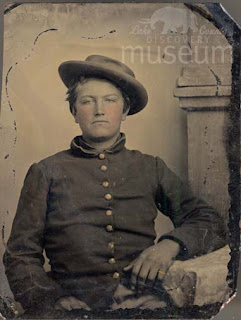James Cole and Nancy Swetnum Cole left Ireland to emigrate with their children to America in 1837. They landed at Quebec, Canada and proceeded to Rochester, New York where they remained for two months before moving to Chicago.
 |
| The Cole's son, Samuel S. Cole, was born in County Cork, Ireland on July 25, 1820. Photographed circa 1880. Dunn Museum 62.62.4.7 |
 |
| Partial view of 8-foot long wooden couch brought from Ireland by the Cole Family in 1837. Dunn Museum 63.22 |
 |
| Another unusual artifact that came down through the generations— a bear trap used by the Coles while living in Shields Township, circa 1840. Dunn Museum 62.62.15 |
The Coles took their profits from the sale and moved to Benton Township. Samuel purchased land on the west side of Sheridan Road at the intersection of today's Shiloh Boulevard in Zion.
In Benton Township, the Coles became acquainted with the Baird family, who had settled there several years previously.
John Baird and Jean Wilson Baird immigrated from Glasgow, Scotland to the United States with their three children, traveling on the Commodore, and arriving at New York on July 3, 1849.
 |
| Passenger list for the Commodore showing the Baird family. Source: Ancestry.com New York, Passenger Lists, 1820-1957 (online) |
The Baird farm was near today's Galilee Avenue and 33rd Street in Zion.
 |
| Scottish immigrant, Jean Wilson Baird (1810-1896) Photographed circa 1893. Dunn Museum 62.62.4.3 |
 |
| The Baird's daughter, Grace Baird Cole, was born in Glasgow, Scotland on September 22, 1837. Photographed circa 1880. Dunn Museum 62.62.4.1 |
In a letter dated November 19, 1849, Baird regales about the quality of farm land and the loveliness of Benton Township: "I am very well pleased with this district of country it is so hilly... the water is good & plenty... to dig down for it if you dig in low ground you will get it in a few feet & if you dig in higher ground you have to go farther down but then the water is colder & purer." (Original letter in the collections of the Chicago History Museum). Thomas Wilson did re-settle his family in Benton Township not long thereafter.
With the Cole and Baird properties relatively close to one another, Samuel Cole and Grace Braid found opportunities to meet through farming activities and Methodist meetings. Within three years of the Coles arriving in the neighborhood, Samuel and Grace were married.
Samuel and Grace had six children: Mary Jane Ferguson (Robert Ferguson), James S. Cole who died in infancy, Samuel N. Cole, Grace N. Ferry (Hiram W. Ferry), Eva E. Carman (Owen Carman), and John J. Cole who died at the age of 26.
 |
| Samuel and Grace Cole's residence as photographed in 1881. The house was located on the west side of Sheridan Road at today's Shiloh Boulevard in Zion. Dunn Museum 62.62 |
Samuel died in July 1895 and left portions of his property to each of his children. Grace died in 1915. Both Samuel and Grace are buried at Lake Mound Cemetery in Zion.
D. Dretske, Curator ddretske@lcfpd.org











































